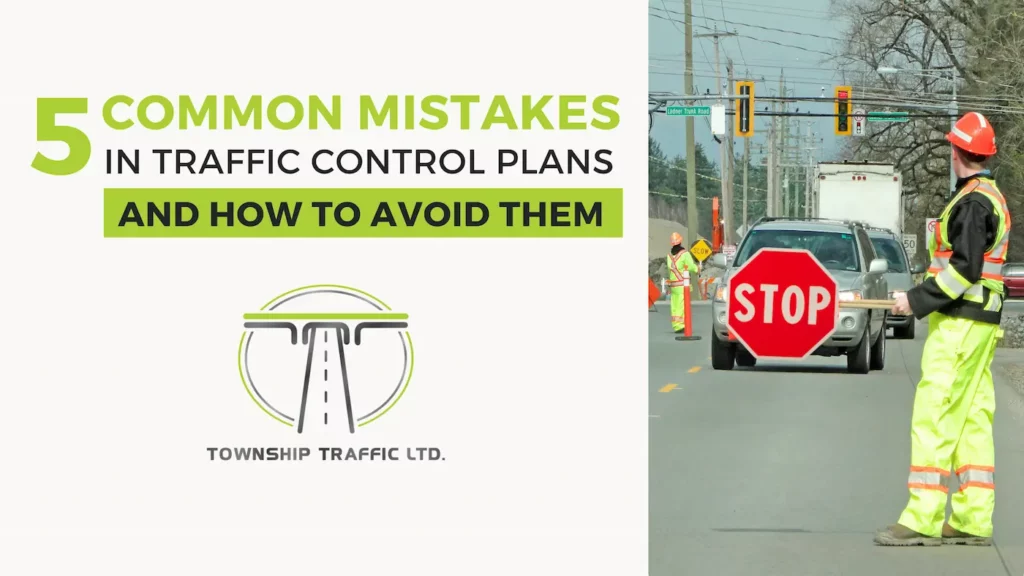Traffic control planning is essential for making sure everyone stays safe, causing as little trouble as possible, and following the rules in your area during roadwork or building projects. It is necessary to have a complete traffic control plan (TCP) in place, regardless of whether you are handling a municipal infrastructure project or a temporary lane restriction. However, planning mistakes often lead to delays, fines, or safety hazards in many projects.
Township Traffic is a company that specializes in delivering licensed traffic management services throughout the province of British Columbia. We assist our clients in streamlining their operations by offering expert planning and execution. This blog post will explore five common mistakes made in traffic control plans and provide strategies to prevent them.
Understanding the importance of thorough site assessments for traffic control is crucial.
It is essential to have a thorough comprehension of the context in which the traffic control plan will be implemented to ensure that it is carried out effectively. Planning professionals run the risk of missing important aspects of the site if they do not conduct a thorough study of it. These aspects include variable traffic volumes, sightline concerns, and significant pedestrian activity. These aspects have a considerable impact on the efficiency and safety of a traffic management strategy, and they must be evaluated with precision and a keen understanding of the local environment.
Through the examination of real-time conditions, such as road geometry, surrounding intersections, and public access routes, professionals in the field of traffic control can build plans that are not only feasible but also by the regulations that are in place in the area. On-site consultations are carried out in great detail by Township Traffic to guarantee that every variable is considered. Such analysis enables the development of control mechanisms that follow the specific dynamics of each project location.
Navigating Provincial Compliance in Traffic Control Planning
Adhering to provincial regulations is a foundational element in any successful traffic control plan. British Columbia’s Ministry of Transportation and Infrastructure (MoTI), along with WorkSafeBC, outlines specific guidelines that must be met to ensure the safety of all roadway users. These standards address everything from signage specifications to personnel certification, and overlooking them can hinder project timelines or lead to enforcement actions.
Working with a traffic control provider that understands these regulatory frameworks is essential. Township Traffic ensures all plans are reviewed and implemented with full compliance in mind, drawing on years of experience navigating British Columbia’s evolving legal landscape. This commitment not only helps clients avoid disruptions but also supports safe and efficient traffic management across a wide range of project types.
The Critical Role of Signage and Equipment Positioning
The placement of signs and equipment plays a vital role in maintaining clear and effective communication with motorists and pedestrians. Poorly placed or outdated signage can create confusion, disrupt traffic flow, and increase the risk of collisions near work zones. Signage must be visible, understandable, and spaced correctly based on road speed and work area length.
Township Traffic takes a strategic approach to sign deployment, ensuring every piece of equipment—from cones and barricades to regulatory signs—is positioned by both practical and regulatory standards. With access to high-quality signage and a skilled installation team, our traffic control solutions provide clarity and confidence for all road users navigating construction and maintenance areas.
The Importance of Certified Traffic Control Personnel
Qualified personnel are the backbone of effective traffic control operations. Certified Traffic Control Persons (TCPs) are trained to manage complex traffic conditions, direct vehicle flow safely, and respond quickly to on-site changes or emergencies. Utilizing uncertified individuals for these roles compromises the safety of workers and the public, particularly in high-volume or high-risk areas.
At Township Traffic, our certified flaggers and control staff are equipped with the skills and knowledge required to handle diverse site conditions throughout British Columbia. Their training ensures that work zones operate smoothly, reducing liability for clients while creating a safer environment for everyone involved.
Integrating Emergency and Contingency Planning into Your TCP
Even the most carefully planned traffic control project must prepare for the unexpected. Unforeseen challenges such as weather disruptions, utility outages, or vehicle accidents can occur with little warning. Without a proactive strategy in place, such events can lead to safety hazards, confusion, and costly delays.
A comprehensive traffic control plan should include contingency measures that allow for quick adaptation. Township Traffic develops responsive strategies, including alternate routes, additional signage, and emergency deployment teams, to support continued operations when standard procedures are disrupted. This level of preparedness ensures both compliance and continuity, regardless of what conditions arise.
Conclusion
Traffic control planning isn’t just about placing cones and signs — it’s about safeguarding lives, ensuring compliance, and keeping your project moving without unnecessary delays. By learning from these common mistakes and partnering with experienced professionals, you set your team up for success on every level.
At Township Traffic, we combine local knowledge, certified expertise, and a proactive approach to deliver traffic solutions that meet today’s complex safety and logistical demands. Ensure the success of your traffic control plan by entrusting it to our team.









